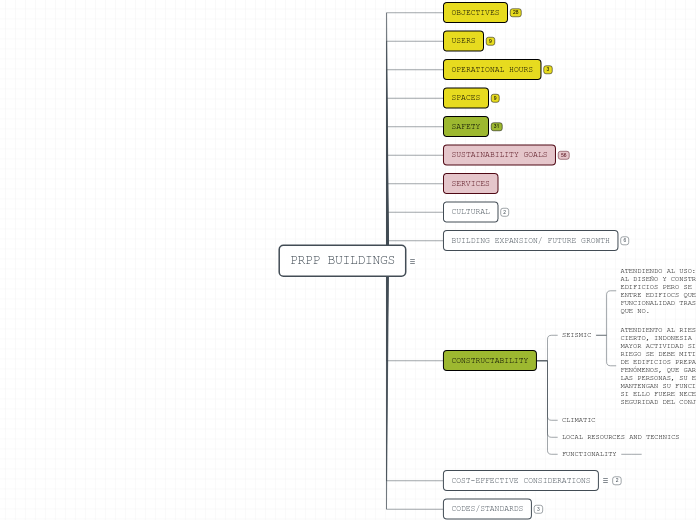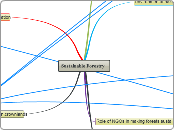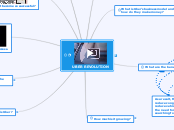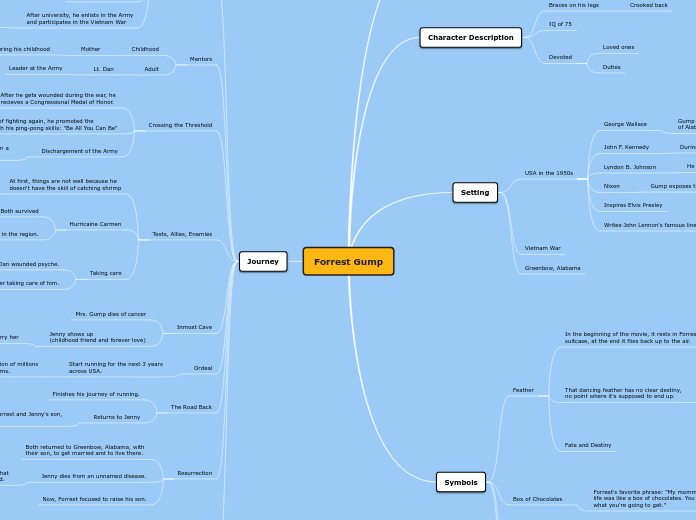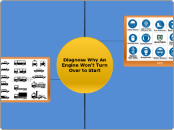LOS SITEMAS CONTRUCTIVOS A EMPLEAR DEBEN SATIFACER LA RESITENCIA AL SITMO, ES POR ELLO QUE LAS ESTRUCTURAS PRINCIPLAMENTE SERÁN DE HORMIGÓN ARMADO O METÁLICAS, LAS DIVISIONES INTERNAS DEEBN GARANTIZAR LA ESTABILIDAD, LAS GRANDES CARGAS DEL EDIFICIO COMO EQUIPOS DE PRODUCIÍN DDE CLIMA O GRANDES ELMENTOS DE MOBIOIARIO O EQUIPAMIENTO DEBE ESTAR LIGADOS DIRECTAMENTE A LA ESTRUCTURA DEL EDIFICIO..........
BUILDINGS HYPOTHESIS REPORT
BUILDINGS DATA SHEETS
1 FOR EACH BUILDING OR BLDG TYP.
Sketches/Diagrams/Benchmark images
Safety
Safe haven
Access
Spaces
Operational hours
Users
SUSTAINABILITY APPROACH
SAFETY GENERAL APPROACH
GENERAL CONSIDERATIONS
ADJACENCIES BASIS OF DESIGN
SPACES TYPOLOGY
BUILDING SHEDULES
CLIMATE REPORT
DESIGN OBJECTIVES AND GUIDING PRINCIPLES
Un tema de exposición de las bases generales que regirá el enfoque y las diferentes hipóteis, escenarios y soluciones.
GUIDING PRINCIPLES
GOALS
EXECUTIVE SUMMARY
Subtopic
PRPP BUILDINGS
The campus shall be designed, developed and constructed later should be covered at least but not limited to;
- The spirit of local values, wisdom and culture
- The spirit of respect to the earth, environment and society
- The spirit of maximize renewable energy
- The spirit of 4R (Reduce, Remove, Recycle and Reuse); waste water, garbage (organic, inorganic and toxic), etc.
- The spirit of green building and green PROPER
- The spirit of respect to the pedestrian
- The spirit of collaboration and tolerance
- The spirit of openness and inclusive
Kadek Ambara Jaya
CODES/STANDARDS
REFERENCES
MANDATORY
PRPP
COST-EFFECTIVE CONSIDERATIONS
Pertains to selecting building elements on the basis of life-cycle costs (weighing options during concepts, design development, and value engineering) as well as basic cost estimating and budget control.
OPEX
CAPEX
CONSTRUCTABILITY
FUNCTIONALITY
LOCAL RESOURCES AND TECHNICS
CLIMATIC
ATENDIENTO AL RIESGO: ESTE ES UN RIEGO CIERTO, INDONESIA ES UNO DELO PAISES CON MAYOR ACTIVIDAD SISMICA DEL MUNDO. eL RIEGO SE DEBE MITIGAR CON LA CONSTRUCCIÓN DE EDIFICIOS PREPARADOS PARA ESTE TIPO DE FENÓMENOS, QUE GARANTICEN LA SEGURIDAD DE LAS PERSONAS, SU EVACAUCIÓN Y QUE MANTENGAN SU FUNCIONALIDAD TRAS EL SISMO SI ELLO FUERE NECESARIO O EXIGIDO POR LA SEGURIDAD DEL CONJUNTO DE LA PLANTA.
ATENDIENDO AL USO: ESTE FACTOR AFECTA A AL DISEÑO Y CONSTRUCCION DE TODOS LOS EDIFICIOS PERO SE DEBE SE DEBE DISTINGUIR ENTRE EDIFIOCS QUE DEBEN MANTENER LA FUNCIONALIDAD TRAS EL SIMSO Y EDIFICIOS QUE NO.
NO MANTIENEN FUNCIONALIDAD TRAS EL SISMO: EL RESTO DE EDIFICIOS
MANTIENEN FUNCIONALIDAD TRAS SISMO: CONTROL ROMM, MEDICAL CENTER, HELIPAD, PARQUE DEBOMBEROS
BUILDING EXPANSION/ FUTURE GROWTH
FORECAST
BY SPACE
BY BUILDING
HOW
ANNEX CONSTRUCTION
MODULARIZATION
CULTURAL
RELIGION
REGIONAL
CLIMATE CHANGE ADAPTATION
OVERFLOW/FLASH FLOOD CONTROL
ENERGY SELF-SUFFICIENT BUILDING
FUTURE CLIMATE FORECAST
HEAT ISLAND MITIGATION
ENVIRONMENTAL PROTECTION
INDOOR ENVIRONMENTAL QUALITY
THERMAL COMFORT
COOLING STRATEGIES
ACOUSTICS
VIBRATION
OUTDOOR NOISE
INDOOR NOISE
VISUAL COMFORT
DAYLIGHTING
AIR QUALITY
OUTDOOR POLLUTANT SOURCES CONTROL
INDOOR POLLUTANT SOURCES CONTROL
VENTILATION
MATERIALS
SUSTAINABLE MATERIAL SELECTION
TRADITION
ORIGIN
DISTANCE
RECYCLED
LCA
ENERGY
RENEWABLE ENERGY
SERVICES
ARTIFICIAL LIGHTING
BUILDING MANAGEMENT SYSTEM
MECHANICAL PERFORMANCE
BUILDING DESIGN
GEOMETRY AND ENVELOPE
PASSIVE COOLING / EVAPORATION
INFILTRATION
THERMAL LAG/
U COEF.
COMPACITY/ SHAPE
BUILDING ORIENTATION
FACADE INSOLATION
NATURAL BIO-CLIMATIC STRATEGIES
SOLAR GAINS
SOLAR PROTECTION
NATURAL VENTILATION
WATER
WATER USE
IRRIGATION
FIXTURES
GREY/BLACK WATER
SUSTAINABLE FRAMEWORK
PROPER
LEED
UNSDG Sustaibable development goals
SAFETY
HEALTH REQUIREMENTS
OTHER HAZARDS
PANDEMICS
NATURAL HAZARDS MITIGATION
https://www.gov.uk/foreign-travel-advice/indonesia/natural-disasters#:~:text=Indonesia%20sits%20along%20a%20volatile,large%20natural%20disasters%20is%20limited.
LAND SLIDES
VOLCANIC ACTIVITY
WILDFIRE
FLOODS
WINDSTORM
TSUNAMI
SEISMIC
EGRESS PATH - EXIT
FIRE
ACCESIBILITY
OVERPRESSURED?
SAFE HAVEN
RESILIENCE MANAGEMENT
RISK
Consequences
Vulnerability
Threat
RESILIENCE
Redundancy
is proposed as another key feature, which mean that there are back-up resources to support the originals in case of failure that should also be considered when planning for resilience.
Recovery
the ability to return to and/or reconstitute normal operations as quickly and efficiently as possible after a disruption. Components of rapid recovery include carefully drafted contingency plans, competent emergency operations, and the means to get the right people and resources to the right places.
Resourcefulness
the ability to skillfully prepare for, respond to and manage a crisis or disruption as it unfolds. This includes identifying courses of action and business continuity planning; training; supply chain management; prioritizing actions to control and mitigate damage; and effectively communicating decisions.
Robustness
the ability to maintain critical operations and functions in the face of crisis. This includes the building itself, the design of the infrastructure (office buildings, power generation, distribution structures, bridges, dams, levees), or in system redundancy and substitution (transportation, power grid, communications networks).
ACCESS RESTRICTIONS
NONE
SOME AREAS
GLOBAL
SPACES
ADJACENCY BOD
INTERIOR CONDITION
COMMON SERVICES
FUNCTIONAL RELATIONSHIPS
SECURITY
ANCILLARY SPACES
OPTIONAL (VALUE + )
RECOMENDED - NON-MANDATORY
MANDATORY SPACES (ACTIVITY RELATED)
OPERATIONAL HOURS
8/5 - 1 SHIFT
12/6 - 2 SHIFTS
24/7 - 3 SHIFTS
USERS
BOOTS TYPE
CATEGORY
WHO IS DOING WHAT AND WHEN?
VISITOR
EXTERNAL
INTERNAL
ACTIVITY SUPPORT
ACTIVITY SPECIFIC
TOTAL OCCUPANCY
OBJECTIVES
SET STRATEGIES
LEVEL OF ACCESS
PRIORITIES AND PHASING
FLOW/MOVEMENT WITHIN THE FACILITY
FLEXIBILITY
CENTRALISATION/DECENTRALISATION
IDENTIFY OPPORTUNITIES
SET CONSTRAINTS
DEFINE SPATIAL REQUIREMENTS
SET FUNCTIONAL RELATIONSHIPS
BY BUILDING TYPE
TECHNICAL, MECHANICAL,SECURITY,... UNIQUE TO THE BUILDING TYPE.
REGIONAL ISSUES INFLUENCE
SITE REQUIREMENTS
TYPICAL COST BY SQM
SPACE CRITERIA
...
SURFACE BY FUNCTION
SURFACE BY USER
TYPE OF SPACES FREQUENTLY PRESENT
SET DESIGN OBJECTIVES
FACILITY MANAGEMENT GOALS
TIME GOALS
SUSTAINABILITY GOALS
ECONOMIC GOALS
FUNCTION GOALS
AESTHETIC GOALS
ORGANISATIONAL GOALS (OWNER)
